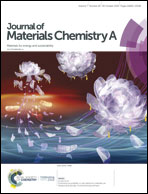“Twisted” conjugated molecules as donor materials for efficient all-small-molecule organic solar cells processed with tetrahydrofuran†
Abstract
High-performance organic semiconductors that can be processed with environmentally benign solvents are highly desirable for printable optoelectronics. Herein, four acceptor–donor–acceptor conjugated molecules, i.e., DRTT-T, DRTT-R, DRTT-OR and DRTT, with 3-ethylrhodanine as acceptor terminal units and 2,5-bis(4,8-di(5-(2-ethylhexyl)thiophen-2-yl)benzo[1,2-b:4,5-b′]dithiophen-2-yl)thieno[3,2-b]thiophene derivatives as donor units were synthesized. 5-(2-Ethylhexyl)thiophen-2-yl, 2-ethylhexyl and 2-ethylhexyloxy were introduced at the β-positions of the central thieno[3,2-b]thiophene (TT) units in DRTT-T, DRTT-R and DRTT-OR, respectively, and unsubstituted TT was used as the central unit in DRTT. As revealed by density functional theory calculations, DRTT-OR and DRTT adopt an almost planar geometry, while DRTT-T and DRTT-R have “twisted” backbones due to the introduction of bulky substituents on TT units. Differing from DRTT-OR and DRTT which are only well soluble in chlorinated solvents such as chloroform, DRTT-T and DRTT-R also show high solubility in “greener” solvents, including toluene and tetrahydrofuran (THF). Non-fullerene small molecule (NFSM) organic solar cells (OSCs) were fabricated with these molecules as donor materials. The molecules (DRTT-T and DRTT-R) with twisted backbones displayed remarkably higher device performance compared to more planar ones (DRTT-OR and DRTT), attributed to the formation of ordered face-on microstructures with π–π stacking distances of 3.7–3.8 Å and interpenetration networks of donor and acceptor components in the blend films based on DRTT-T and DRTT-R. Most importantly, the power conversion efficiencies (PCEs) of DRTT-T and DRTT-R based devices processed with THF reached 9.37% and 10.45%, respectively. This study demonstrates that “twisting” conjugated backbones is an appropriate strategy to design eco-friendly solvent processable organic semiconductors for high-efficiency OSCs.



 Please wait while we load your content...
Please wait while we load your content...